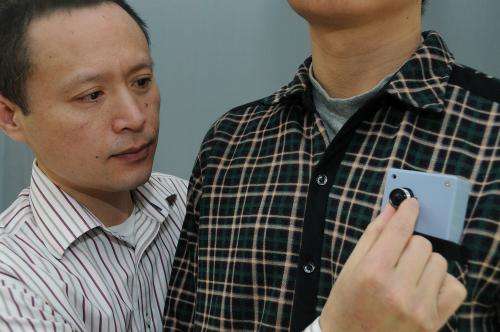Wearable device helps vision-impaired avoid collision

People who have lost some of their peripheral vision, such as those with retinitis pigmentosa, glaucoma, or brain injury that causes half visual field loss, often face mobility challenges and increased likelihood of falls and collisions. As therapeutic vision restoration treatments are still in their infancy, rehabilitation approaches using assistive technologies are often times viable alternatives for addressing mobility challenges related to vision loss.
Researchers from Massachusetts Eye and Ear, Schepens Eye Research Institute used an obstacle course to evaluate a wearable collision warning device they developed for patients with peripheral vision loss. They found the device may help patients with a wide range of vision loss avoid collisions with high-level obstacles. Their findings are featured on Investigative Ophthalmology and Visual Science (IOVS).
"We developed this pocket-sized collision warning device, which can predict impending collisions based on time to collision rather than proximity. It gives warnings only when the users approach to obstacles, not when users stand close to objects and not when moving objects just pass by. So, the auditory collision warnings given by the device are simple and intuitively understandable. We tested the device in a density obstacle course to evaluate its effect on collision avoidance in people with peripheral vision loss. To show its beneficial effect, we compared the patients' mobility performance with the device and without it. Just demonstrating the device can give warning for obstacles in walking would not prove the device is useful. We have to compare with a baseline, which is walking without the device in this case." said the senior author Gang Luo, Ph.D., Associate Scientist at Mass. Eye and Ear/Schepens, and Assistant Professor of Ophthalmology at Harvard Medical School.
Twenty five patients with tunnel vision or hemianopia completed the obstacle course study and the number of collisions and walking speed were measured.
Compared to walking without the device, collisions were reduced significantly by about 37% with the device and walking speed barely changed. No patient had more collisions when using the device than when not using it.
"We are excited about the device's potential value for helping visually impaired and completely blind people walk around safely. Our next job is to test its usefulness in patients' daily lives in a clinical trial study." Dr. Luo said.
This study is entitled Evaluation of a portable collision warning device for patients with peripheral vision loss in an obstacle course. Other authors are Shrinivas Pundlik and Matteo Tomasi.
Provided by Massachusetts Eye and Ear Infirmary

















